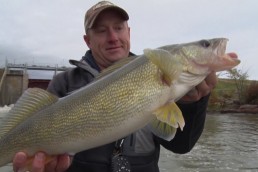Taking River Smallmouth on Spinnerbaits
SHARE THIS POST
June is one of my favorite months for river smallmouth fishing. It just seems as though everything points toward success on the water. The weather is right, bug hatches are taking place, the baitfish are on the move, the water levels usually are pretty stable and the fish are biting.
Over the decades, smallmouth fishing in the rivers of the upper Midwest has become my passion—right up there with duck hunting—and I’m always ready to get back to the river. Especially this year since I had knee surgery in February for a torn meniscus and a bone fracture. About the only fishing I have done is pond fishing for bluegills and largemouth bass. That was done mostly from a chair on the bank. Now I am healed, and the fish are trembling!
There is a plethora of ways to take river smallies, from floating Rapalas, swim baits, Blue Fox spinners, tubes and other soft plastics, but I really like to fling spinnerbaits at them. As we all know, the spinnerbait resembles nothing that is found in nature, but it certainly does catch fish. The combination of vibration, thump, flash, bling and sound appeals to all the senses and attracts even those finny critters that are in a neutral mood. There is nothing in the world of river fishing that beats getting into a fight with a red-eyed smallie that wants to take your lure away from you.
Working upstream
So, where to begin? I like to park my truck near a bridge, slip into hip boots, tie on a wading stick and start working upstream. River bass live and die by the current. They spend about 95 percent of their time looking upstream. Why? Because this is the direction from which their food will flow. Accordingly, I make about 95 percent of my casts in that direction and work the lure back towards myself.
Bridge abutments hold logs, grass and other river flotsam that provide perfect hiding places for baitfish. Smallmouths instinctively know this and can be found there, searching for something to eat. Make your casts parallel to the debris and the abutments and be ready for a strike at any time. Just downstream from the bridge, there should be a washout. Even if it is only a couple of feet deeper, it may hold a fish or two. Don’t miss making a cast or two into it.
Moving upstream, look for any riffles or current breaks—these most likely will hold fish. Make your first casts at the base of the riffle and work the lure all the way back to your position, then a yard or two beyond. Smallmouths are notorious followers and may surprise you by striking at the lure just as you are raising it from the water. Always be ready. Don’t stand with your legs spread widely apart. A fish may dart between them, causing mayhem or tearing your waders with an exposed hook.
Are you enjoying this post?
You can be among the first to get the latest info on where to go, what to use and how to use it!
After you have thoroughly fished the riffle base, make a few casts at its head. Smallies may be up there chasing minnows or crawdads. As you cast, look for emergent weeds, make casts parallel to them and don’t worry about getting snagged. Besides all of its flash and bling, the spinnerbait proves itself to be a great river lure due to its ability to ride through the weeds. At this time of year, I have seen smallmouths rooting in the weeds and have caught them with a well-placed cast.
Locations to lock on
Blown-down trees, pools, eddies, rock piles, lily pads—all are potential hotspots for taking a few fish. Where the water is deeper, let the lure sink for a couple of seconds. Then, keep up a steady retrieve. No luck? Yo-yo it back to your position. Better yet, drag it near the bottom. In shallower water, try “waking it”—keeping your rod tip high and running just under the surface. Many times, this will provoke neutral fish into a strike. On a river bend, fish the outside bend where there is deeper water. Start with a fast retrieve. No takers? Slow it down. Experiment and let the fish tell you what they want.
Don’t be afraid to change lures. If I had to pick one color for river spinner baitin’, it would be black with a black/yellow skirt, one silver willow leaf blade and one gold willow leaf. Why the willow leaf? The fish, most likely, will be chasing minnows and this blade imitates the bait. If the river were murky, I might switch to Colorado blades to provide extra thump.
There are so many brands of spinnerbaits on the market that it almost defies the imagination. The prices vary from “bargain bin” to absolutely ridiculous. All will catch fish under the right conditions. Choose six to eight lures in various colors (with an emphasis on black, white and chartreuse) and sizes. Spinning rod or casting rod doesn’t matter much, just use what suits you the best. Keep your line fresh and free from nicks and do not use a swivel. Either tie directly to the lure or use a small snap with which to change lures.
For safety’s sake, I would not think of entering the water without a wading stick of some kind. Round out your gear with a pair of shades, some insect spray and a bottle of water and you are good to go on the river.
MWO
SHARE THIS POST
Did you enjoy this post?
You can be among the first to get the latest info on where to go, what to use and how to use it!
John Bennett
John Bennett is a retired history teacher, historical re-enactor, father and grandfather. As a four-season outdoorsman, his passion is waterfowl hunting and fishing for smallmouth bass. He lives in Ohio and spends quite a bit of time in his primitive log cabin, which he built.



